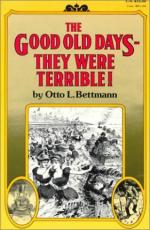
|
| Name: _________________________ | Period: ___________________ |
This test consists of 5 multiple choice questions, 5 short answer questions, and 10 short essay questions.
Multiple Choice Questions
1. According to Bettmann in "Air," many people were cramped together in windowless rooms in the tenements during the summer, causing:
(a) Heat stroke and dehydration.
(b) Landlords to lower rents.
(c) Many people to flee the cities.
(d) An increase in determination to succeed in the working class.
2. Women on the frontier in the late 1800s also endured the hard work of what daily chore?
(a) Cooking.
(b) Chicken care.
(c) Laundry.
(d) Sewing.
3. Just like their male counterparts, frontier women after the Civil War endured:
(a) Lack of voting rights.
(b) Harsh weather.
(c) Back-breaking labor.
(d) Small town life.
4. Why did tenants in the late 1800s have such big problems when it came to housing in the big cities?
(a) Landlords did not allow animals.
(b) They had no laws to protect them.
(c) A lease was seldom renewed.
(d) There was too much housing to chose from.
5. According to Bettmann in "Rural Life," what frontier necessity was often a cesspool of contamination?
(a) The barn.
(b) Nearby streams.
(c) The local well.
(d) The outhouse.
Short Answer Questions
1. According to Bettmann in "Housing," how did apartments turn into vertical versions of tenements?
2. In what decade was window screening introduced?
3. What danger did many industrial laborers face in the latter part of the 19th century?
4. In the late 1800s, who was it that posed a threat to those on the frontier and instilled a sense of fear?
5. What kind of work did the young rural girls often find in the cities in the late 1800s?
Short Essay Questions
1. In the era after the Civil War, what was a major cause of the hideous traffic problems in the large American cities like New York?
2. How did winter pose a health hazard on the frontier?
3. What was the area in New York that was the worst air pollution offender in the late 19th century?
4. How did landlords take unfair advantage of their tenants in the late 19th century?
5. Who constructed the first apartment building, and why was it created?
6. How did railroads contribute to the pollution and danger for many cities?
7. What was the El Train, and what was it's purpose when it was introduced in 1868?
8. What was New York's shantytown, and who lived there in the late 19th century?
9. How did many farmers on the frontier become financially in debt?
10. According to the chapter "Air," what were some of the problems with using a streetcar for transportation?
|
This section contains 764 words (approx. 3 pages at 300 words per page) |

|




